You’ll choose between vises and clamps based on your project’s specific needs—vises offer superior clamping pressure with dual jaws and permanent mounting for stability, while clamps provide portable flexibility for temporary holding. For jewelry work, you’ll need precision vises with padded jaws, swivel bases, and compact designs to protect delicate materials. Select specialized tools like ring clamps, micro clamps, and soft jaw vises depending on your workpiece requirements. Master these fundamentals and you’ll discover advanced techniques that elevate your craftsmanship to professional levels.
Understanding the Fundamental Differences Between Vises and Clamps
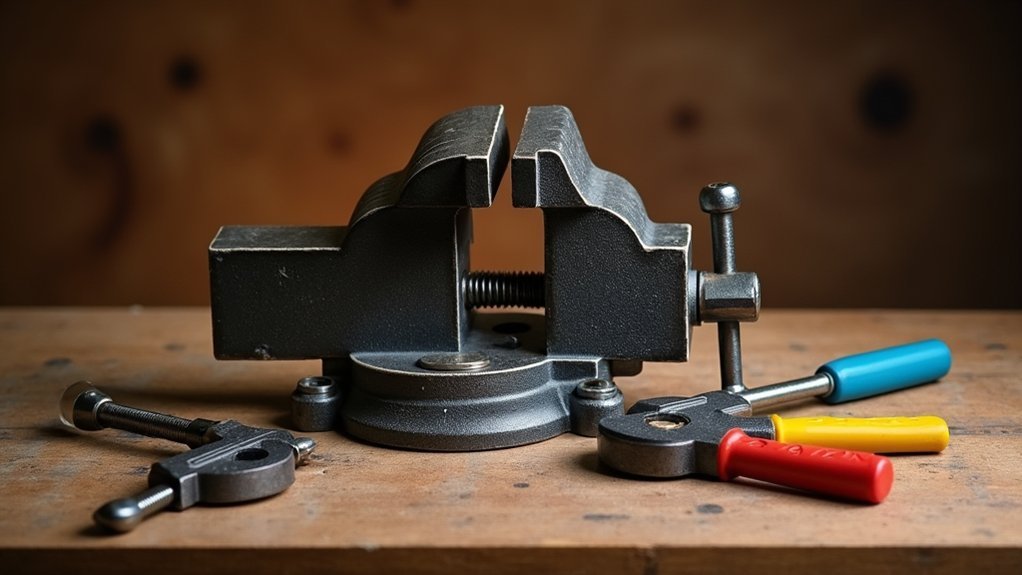
When you’re deciding between vises and clamps for your workshop, you’ll need to understand their distinct design purposes and capabilities.
Vises feature two jaws—one fixed, one movable—that deliver exceptional clamping pressure across a wider contact area. You’ll measure vise size by jaw width and opening capacity, making them perfect for heavy-duty tasks requiring maximum stability.
Vises deliver superior clamping force through dual-jaw design, measured by jaw width and opening capacity for maximum workpiece stability.
Clamps serve different needs entirely. They’re designed for temporary holding applications where flexibility matters most. You’ll find various types like bar clamps and C-clamps, each offering portability that vises can’t match.
While vises mount permanently to your workbench for consistent reliability, clamps move easily between projects.
Choose vises when securing workpieces for precision drilling, sawing, or filing. Select clamps for assembly work, gluing, or temporary material positioning.
Essential Types of Jewelry Vises for Precision Work
When you’re working on intricate jewelry projects, you’ll need vises designed specifically for precision tasks that require both security and gentleness.
These specialized tools feature soft jaws that won’t damage delicate metals and stones while maintaining the firm grip you need for soldering, stone setting, and detailed metalwork.
Understanding the key features of precision jewelry vises and mastering specialized clamping techniques will elevate your craftsmanship and protect your valuable materials.
Precision Jewelry Vise Features
Precision forms the cornerstone of exceptional jewelry work, and specialized vises deliver the exact control you need for intricate projects.
Precision jewelry vises feature small, adjustable jaws that securely grip delicate workpieces without causing damage. You’ll find padded jaws made from rubber or soft plastic materials that protect precious metals and gemstones from scratches or marring during handling.
A swivel base allows you to rotate your work effortlessly, providing ideal access from multiple angles while maintaining a firm grip.
Many models include integrated anvil surfaces, giving you additional functionality for shaping or flattening metal without requiring separate tools.
These compact vises offer exceptional stability and precision, making them perfect for small workspaces.
You can confidently perform detailed tasks like soldering, filing, and stone setting.
Specialized Clamping Techniques
Different types of jewelry vises excel at specific tasks, and understanding their unique applications will elevate your precision work considerably.
Each vise’s design addresses specific needs through specialized features that enhance control and protect delicate materials.
Essential jewelry vises include:
- Ring clamps – Designed specifically for securely holding rings while you work on bands and settings without obstruction.
- Rotating base vises – Allow 360-degree access to your workpiece when securely mounted, eliminating constant repositioning.
- Soft jaw vises – Feature plastic or rubber clamping surfaces that prevent marring during delicate operations.
You’ll find that matching your vise selection to your project requirements guarantees ideal results.
Consider jaw width, opening capacity, and clamping surface materials when choosing jewelry vises for precision work like soldering, stone setting, and polishing tasks.
Specialized Clamps for Delicate Jewelry Projects
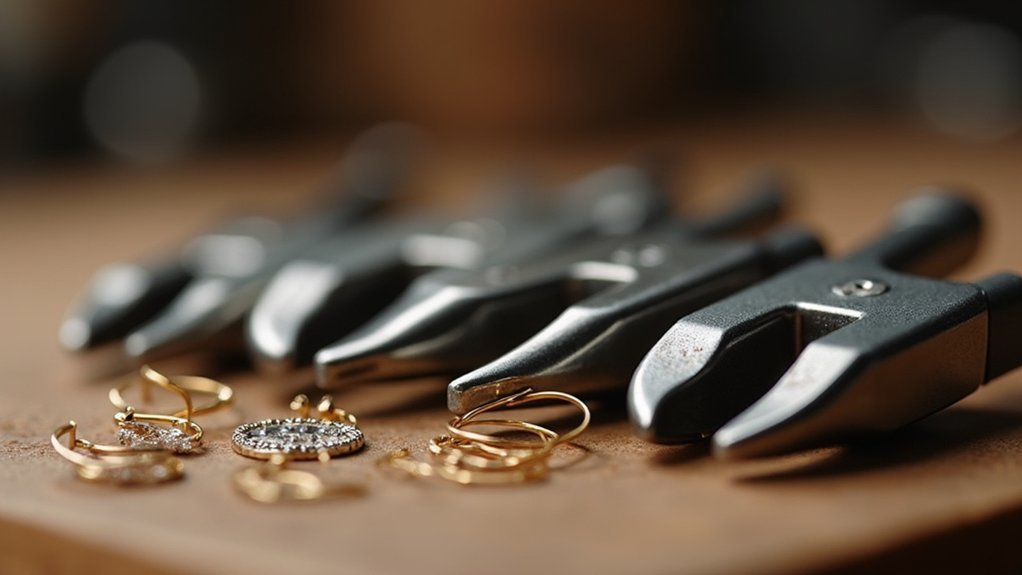
When you’re working on intricate jewelry pieces, you’ll need micro clamps that can grip tiny components without crushing or distorting them.
Your clamp selection should prioritize precision over brute force, focusing on models designed specifically for small-scale metalwork and gem setting.
The jaw materials you choose will determine whether your finished pieces show tool marks or maintain their pristine surfaces throughout the crafting process.
Micro Clamp Selection
Three essential characteristics define quality micro clamps for jewelry work: precise grip control, minimal contact pressure, and exceptional maneuverability in tight spaces.
When selecting micro clamps, you’ll want adjustable jaws that accommodate various workpiece sizes while maintaining stability throughout intricate procedures.
Consider these critical features when choosing micro clamps:
- Throat depth – Select shallow depths for accessing confined areas without obstruction.
- Protective pads – Choose clamps with cushioned jaws to prevent marring delicate surfaces.
- Construction materials – Opt for lightweight designs that enhance precision handling during detailed work.
Your micro clamps should provide consistent pressure without damaging intricate components during soldering, drilling, or assembly tasks.
The adjustable jaw mechanism guarantees you’ll achieve peak grip strength while the protective elements safeguard your finished jewelry pieces from scratches or surface damage.
Protective Jaw Materials
Since delicate jewelry components require specialized protection during clamping operations, you’ll need clamps equipped with soft jaw materials that cushion precious metals and gemstones from damage.
Protective jaw materials like rubber and plastic prevent marring while distributing pressure evenly across fragile surfaces. You can’t afford marks or indentations when working with pearls, thin metal sheets, or intricate settings.
Choose clamps with padded jaws that grip securely without compromising your workpiece integrity.
Adjustable jaw designs accommodate various shapes and sizes, ensuring you maintain precision control during assembly and repair tasks.
These specialized protective jaw materials allow you to work confidently with valuable jewelry pieces, knowing your tools won’t leave unwanted marks.
Professional jewelers and hobbyists alike benefit from investing in quality clamps designed specifically for delicate applications.
Key Features to Consider When Selecting Jewelry Vises
While jewelry making requires exceptional precision and delicate handling, choosing the right vise can make the difference between a flawless piece and costly damage to your materials.
When selecting jewelry vises, you’ll want to prioritize features that protect your work while meeting precision demands.
Essential features to look for include:
- Adjustable jaws with soft jaw padding – These prevent scratches on precious metals and gemstones while accommodating varying piece sizes.
- Swivel base functionality – This allows multi-angle positioning for intricate design work and improved accessibility.
- Sturdy construction materials – Cast iron or high-strength plastic guarantees durability under demanding conditions.
Consider a portable design if you’ll work at different locations or craft shows.
The right combination of these features guarantees your jewelry vise supports professional-quality results.
Proper Mounting Techniques for Optimal Stability
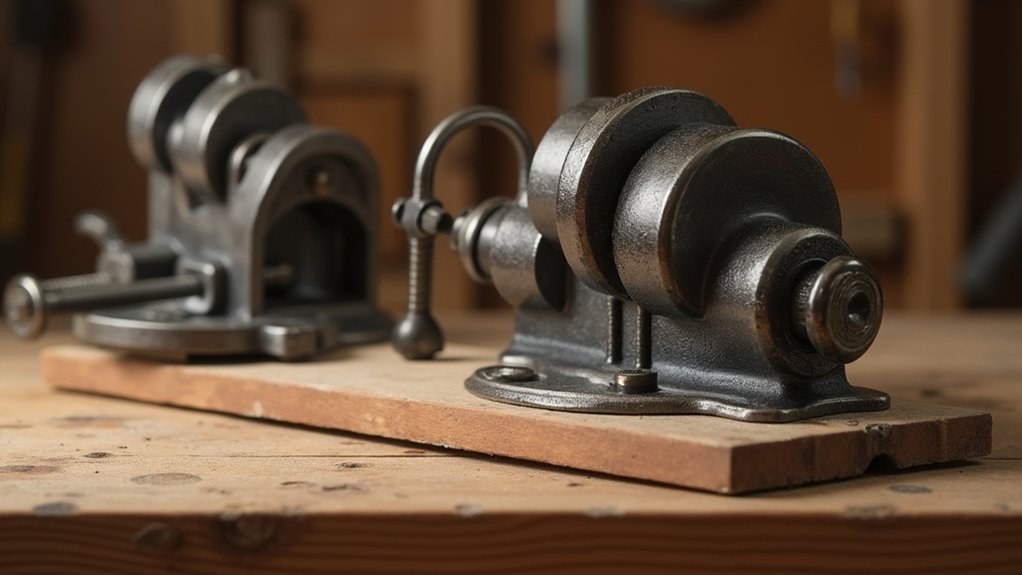
You’ll need to secure your vise properly to maximize its performance and guarantee safe operation during demanding tasks.
Different workbench attachment methods offer varying levels of stability, from permanent bolt-through installations to temporary clamp-on systems.
Understanding how to assess stability factors will help you choose the right mounting approach for your specific workshop needs and applications.
Workbench Attachment Methods
Although workbench attachment methods vary greatly, proper mounting techniques directly impact your vise’s stability and performance during demanding tasks.
When you’re selecting the right approach, you’ll need to evaluate your specific needs and workspace requirements.
Here are three primary attachment methods to evaluate:
- Permanent bolt-through mounting – Mount your vise at waist height using heavy-duty bolts for maximum stability and ergonomic operation.
- Temporary clamp-on systems – Utilize clamp-on vises or vacuum bases for flexibility, though they’ll reduce clamping force.
- Hybrid mounting solutions – Combine permanent brackets with removable vise heads for versatility.
Ensure your workbench surface remains level and perform regular maintenance by checking bolt tightness.
Position your mounted vise near tools, lighting, and power sources to maximize workspace efficiency during heavy-duty operations.
Stability Assessment Factors
When mounting your vise, several critical factors determine whether it’ll provide the rock-solid stability you need for precision work. First, verify your vise is mounted at waist height to maintain ergonomic positioning and reduce strain during extended use.
Heavy-duty bolts create the secure foundation necessary for demanding applications, preventing unwanted movement that compromises accuracy.
For portable setups, carefully evaluate clamp-on or vacuum-base options to balance stability with mobility. Position your mounted vise near essential tools, lighting, and power sources to maximize workflow efficiency.
Regular maintenance tips include inspecting mounting hardware for wear and looseness. This simple routine will prevent accidents and maintain peak stability throughout your vise’s lifespan.
Proper assessment guarantees your workspace remains both safe and productive.
Safety Precautions for Jewelry Workshop Operations
Since jewelry work involves intricate tasks with sharp tools and delicate materials, establishing proper safety protocols becomes essential for protecting both yourself and your creations.
These safety precautions help prevent accidents and guarantee your clamps and vises perform at their best during detailed operations.
- Secure workpieces securely in vise jaws before beginning any operation, as the mechanism allows for stable positioning that prevents dangerous movement during cutting or drilling.
- Inspect your equipment regularly for wear or damage, checking that adjustment screws and locking mechanisms function properly to maintain reliable performance.
- Maintain proper workspace organization using magnetic strips for tools and adequate LED lighting to eliminate shadows that could compromise precision when you secure pieces.
Regular equipment maintenance guarantees your safety while protecting valuable materials from costly mistakes.
Advanced Clamping Techniques for Complex Jewelry Tasks
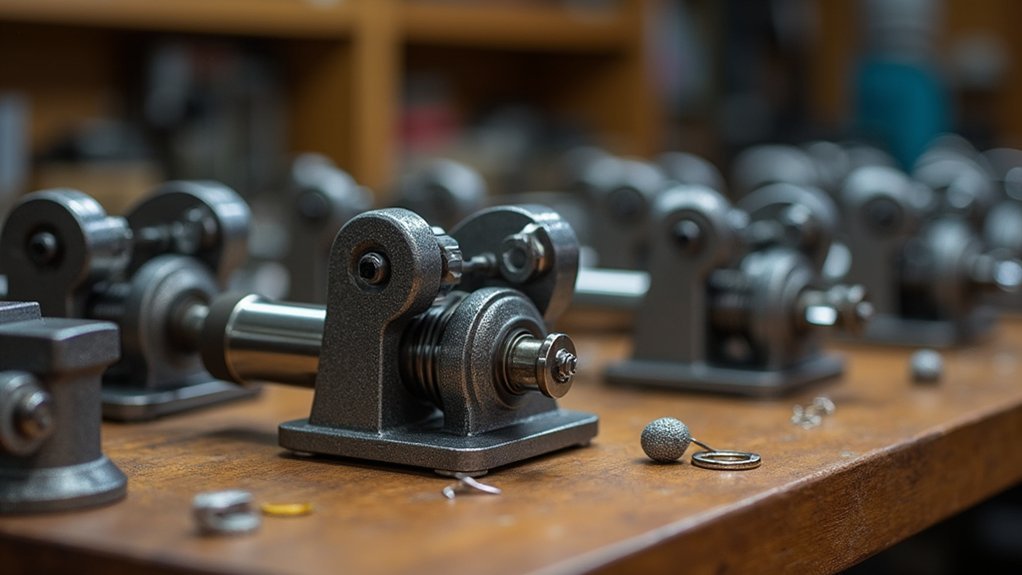
While mastering basic clamping keeps your jewelry pieces secure, complex projects demand specialized techniques that accommodate intricate geometries and delicate materials.
Advanced clamping techniques for jewelry tasks require strategic tool selection based on your workpiece characteristics.
Spring clamps excel at holding delicate components without surface damage, perfect for small jewelry pieces requiring gentle pressure.
C-clamps with protective pads secure workpieces firmly while cushioning against excessive force.
Bench vises equipped with soft jaws accommodate irregularly shaped items during precision work like soldering or stone setting.
Trigger clamps offer one-handed operation for quick adjustments when managing multiple components in intricate assemblies.
For larger multi-part pieces, bar clamps distribute pressure evenly across entire workpieces, ensuring consistent results throughout complex jewelry construction projects.
Maintenance and Care for Long-lasting Performance
Although quality vises and clamps can last for decades with proper attention, neglecting their maintenance will quickly diminish their precision and reliability. To guarantee long-lasting performance, you’ll need to establish consistent care routines that maintain safety and prevent damage.
Consistent maintenance routines are essential for preserving the precision and reliability of quality vises and clamps over decades of use.
Your maintenance schedule should include these essential tasks:
- Regularly clean the jaws and mechanisms after each use to remove debris and grime that can interfere with smooth operation.
- Lubricate moving parts at least every six months to reduce friction and extend tool life.
- Inspect for signs of wear periodically, checking for cracks, loose components, and jaw deterioration.
Store your tools in dry, organized spaces to protect their mechanisms.
When purchasing new equipment, choose durable materials like forged steel that withstand rigorous use while maintaining their effectiveness over time.
Common Mistakes That Damage Jewelry Workpieces
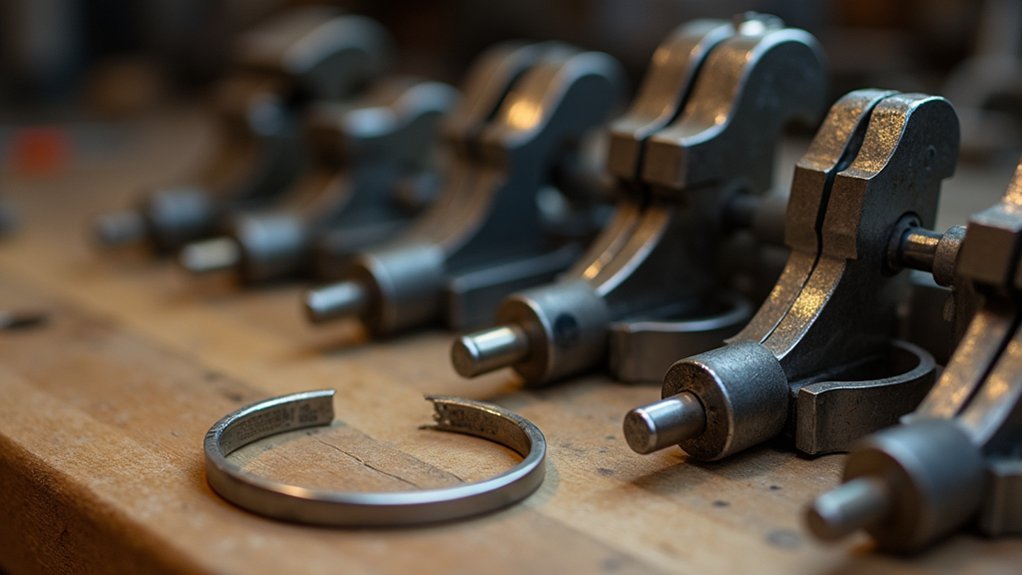
When working with precious metals and delicate gemstones, even minor handling errors can transform a beautiful jewelry project into an expensive mistake. Over-tightening the vise causes deformation and cracking, while dirty jaws create scratches requiring extensive polishing. Always use protective pads and soft jaws when handling delicate materials to avert permanent indentations.
| Mistake | Consequence | Prevention |
|---|---|---|
| Over-tightening | Deformation/cracking | Apply even pressure gradually |
| Dirty/worn jaws | Surface scratches | Regular cleaning and inspection |
| Misalignment | Warped components | Check positioning before clamping |
Misalignment creates uneven pressure distribution, warping your pieces beyond repair. Regular inspection prevents wear and tear from causing component failure, which can drop and damage fragile workpieces. Proper technique protects your investment and guarantees professional results.
Professional Tips for Maximizing Tool Efficiency
Since professional-grade results depend heavily on proper technique and tool maintenance, maximizing your vise and clamp efficiency requires a systematic approach that goes beyond basic operation.
Your bench vice becomes notably more versatile with these essential upgrades:
- Install protective jaw inserts when working with materials like wood or soft metals to prevent surface damage while holding workpieces securely in place.
- Choose a swivel base mechanism that allows 360-degree rotation, expanding your clamping range and eliminating constant repositioning.
- Implement dynamic positioning techniques for efficient use of time during complex projects.
Regular maintenance proves equally important—lubricate screws and sliding surfaces every six months to reduce friction.
Organize your workspace by tool frequency, keeping frequently used clamps within arm’s reach to minimize workflow interruptions and maximize productivity.
Frequently Asked Questions
What Is the Average Lifespan of a High-Quality Jewelry Vise?
You’ll find a high-quality jewelry vise typically lasts 15-25 years with proper maintenance. If you’re using it professionally daily, expect the lower range. Hobbyists who use theirs occasionally often see 20+ years of reliable service.
Can I Use Woodworking Vises for Jewelry Making Projects?
You can use woodworking vises for basic jewelry tasks, but they’re not ideal. They lack the precision, delicate grip control, and small-scale adjustability that dedicated jewelry vises provide for detailed metalwork.
How Much Should I Budget for a Complete Jewelry Clamping Setup?
You’ll need $150-400 for a complete setup. Budget $50-150 for a jeweler’s bench vise, $30-80 for ring clamps, $20-60 for third hands, and $50-100 for specialized pliers and holding tools.
Are There Left-Handed Specific Vises Available for Jewelry Work?
You’ll find most jewelry vises aren’t specifically designed for left-handed users, but you can adapt standard vises by repositioning them or choosing models with reversible jaws and adjustable mounting systems.
What Warranty Coverage Typically Comes With Professional Jewelry Vises?
You’ll typically find one to five-year warranties covering manufacturing defects and material failures. Premium brands often offer longer coverage, but normal wear, misuse, and damaged jaws aren’t usually included in standard warranty terms.
In Summary
You’ve now mastered the essentials of jewelry vises and clamps. Don’t rush your selections—invest in quality tools that’ll serve you for years. Remember to mount them properly, maintain them regularly, and avoid those common mistakes that can ruin your workpieces. Practice the advanced techniques we’ve covered, and you’ll find your precision work becomes more efficient and professional. Your jewelry projects will reflect the care you’ve put into choosing and using the right tools.

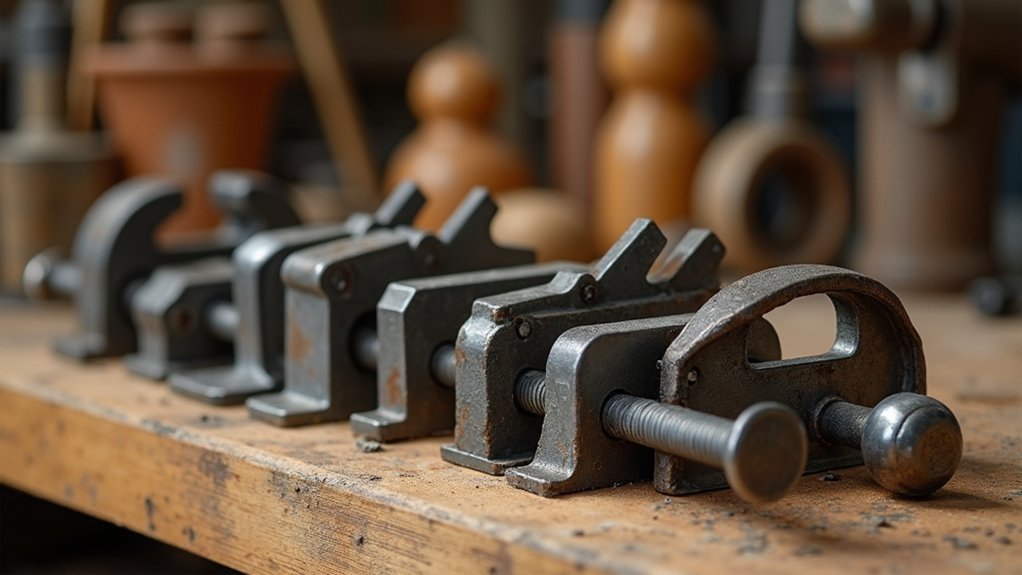



Leave a Reply